The Cultural Travel Market is estimated to be valued at USD 524.4 million in 2025 and is projected to reach USD 984.3 million by 2035, registering a compound annual growth rate (CAGR) of 6.5% over the forecast period.
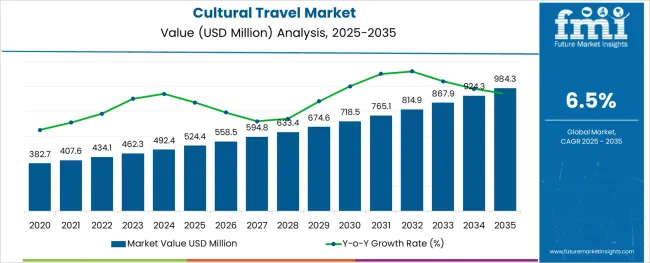
The cultural travel market is experiencing considerable growth, fueled by travelers seeking immersive and authentic cultural experiences. Increasing disposable incomes and a global desire to explore heritage and traditions have expanded the market. Cultural festivals and events have become major attractions, drawing both domestic and international tourists.
Infrastructure improvements and increased accessibility to heritage sites have further encouraged travel. The rise of group travel packages has simplified the experience for many, providing curated itineraries and social engagement opportunities.
Road travel remains popular due to its flexibility and ability to access remote cultural destinations. This market is expected to grow as travelers prioritize experiential tourism that connects them deeply with local customs and celebrations. Segmental growth is anticipated to be led by group travelers, festival participation, and roadways as the preferred mode of travel.
The market is segmented by Traveler Type, Activity Type, and Mode of Travel and region. By Traveler Type, the market is divided into Group and Solo. In terms of Activity Type, the market is classified into Festivals and Rituals. Based on Mode of Travel, the market is segmented into Roadways, Airways, and Waterways. Regionally, the market is classified into North America, Latin America, Western Europe, Eastern Europe, Balkan & Baltic Countries, Russia & Belarus, Central Asia, East Asia, South Asia & Pacific, and the Middle East & Africa.
The market is segmented by Traveler Type, Activity Type, and Mode of Travel and region. By Traveler Type, the market is divided into Group and Solo. In terms of Activity Type, the market is classified into Festivals and Rituals. Based on Mode of Travel, the market is segmented into Roadways, Airways, and Waterways. Regionally, the market is classified into North America, Latin America, Western Europe, Eastern Europe, Balkan & Baltic Countries, Russia & Belarus, Central Asia, East Asia, South Asia & Pacific, and the Middle East & Africa.
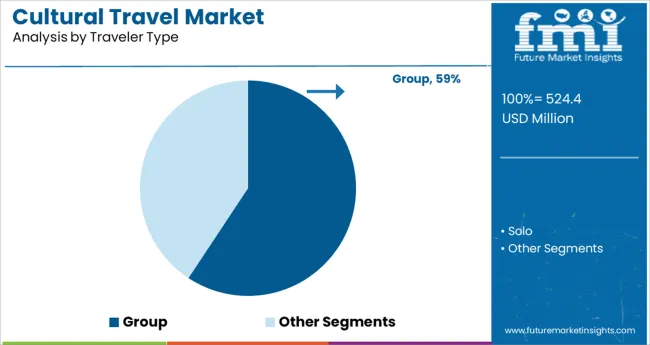
The Group traveler segment is expected to account for 59.3% of the cultural travel market revenue in 2025, establishing it as the largest traveler category. Group travel offers convenience through organized itineraries, often including guides and pre-arranged cultural activities.
Many travelers prefer groups for the social aspect and ease of navigating unfamiliar destinations. Travel agencies and tour operators have expanded group packages focusing on cultural themes, enhancing accessibility for diverse demographics.
Group travel also offers cost efficiencies and safety assurances, which appeal to families, seniors, and first-time cultural tourists. These factors contribute to the sustained preference for group travel in cultural tourism.
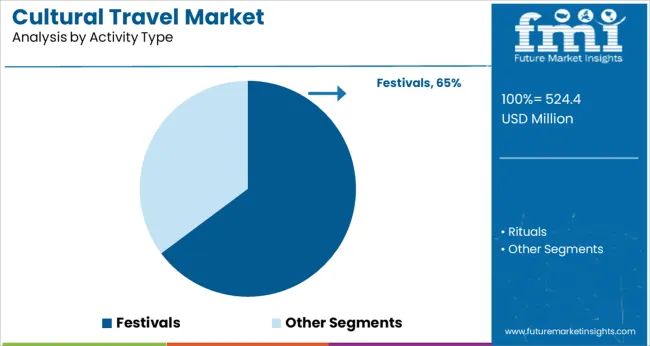
The Festivals segment is projected to contribute 64.8% of the cultural travel market revenue in 2025, highlighting its dominance among cultural activities. Festivals provide immersive experiences that showcase traditional music, dance, cuisine, and religious practices.
These events often serve as gateways for travelers to connect with local communities and gain insights into cultural heritage. Festival tourism benefits from extensive promotion by local governments and cultural organizations, attracting large crowds annually.
The emotional and experiential appeal of festivals has also been enhanced by social media sharing and influencer endorsements, broadening global reach. Continued investment in festival infrastructure and programming is expected to maintain this segment’s growth.
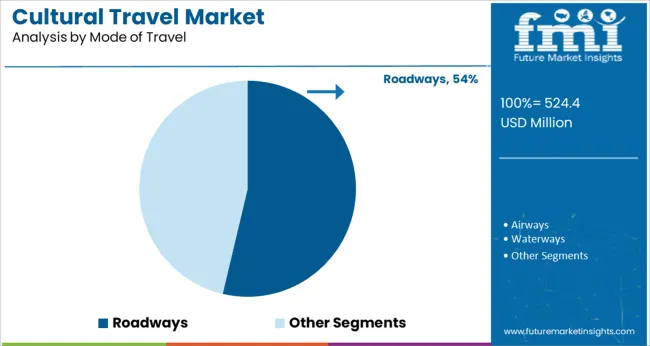
The Roadways segment is expected to hold 53.7% of the cultural travel market revenue in 2025, positioning it as the preferred travel mode. Road travel offers flexibility, allowing travelers to explore multiple cultural sites at their own pace.
Many cultural destinations, especially in rural or less accessible areas, are best reached by road. The affordability of road travel compared to air or rail makes it popular among budget-conscious travelers.
Additionally, road trips enable travelers to experience local landscapes and communities en route, enriching the cultural journey. Improvements in road infrastructure and the growth of car rental services and ride-sharing platforms have further boosted the popularity of roadways for cultural tourism.
The cultural travel market has received a lot of traction in the industry.
Millions of tourists traverse the developing tourism arena, eager to gain knowledge about a new place, seeking to expand their knowledge horizon. The cultural tourism segment welcomes a huge influx of tourists looking to embark on a journey of discovery. Cultural travel offers an opportunity for traveller’s keen to uncover the secrets behind any place in the world, increasing the adoption of cultural travel.
Culture travel enjoys ample growth amid the all-round development of the tourism industry. The cultural travel industry is also greatly benefited by the slew of promotional measures by several governments to promote dimming cultures. The emergence of a new generation of tourists, who are opulent and educated, also provides adequate fodder for the development of culture travel.
There has been a global decline in cultural travel, which can be attributed to a number of things: terrorism and natural disasters have caused many cultures to be smashed by the wrath of terrorism in the last few years; the rapid growth of millennials as tourists has slowed cultural travel as a potential tourism experience while the aforementioned factors have diminished the surge, influencing the cultural travel market share.
There has been a marked shift in the spending patterns of cultural travellers over recent years, who spend 37 percent more on travel than mainstream travellers. Hotels and luxury accommodations also earn more as cultural tourists stay longer in a cultural location. Experimental tourism is also redefining the contours of cultural travel.
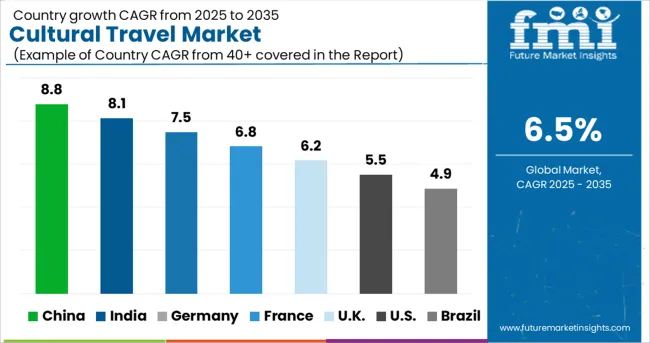
Italy and Germany will grow faster than the market's growth in other regions during the forecast period. The growth of the cultural travel market will be more rapid in Europe than any other region.
In this troubled economic time, culturally rich countries have been promoting this extremely rich form of tourism for the last few years. Cultural tourism does more than fulfill tourists' wanderlust; it also preserves some of the world's abrogating cultures. Cultural travel is a marriage between past and present.
In the last few years cultural travel has generated huge revenue for several culturally rich countries, and tourism destinations with a high creative content have been drawing the maximum crowd. Festivals, theme shows, and cultural extravaganzas have captivated millions and broke all barriers for decades and the trend continues. South-east Asia, North America, Europe, and Africa are some of the regions the cultural travel market dominates.
Tourism is one way to promote local cultures. Governments around the world are partnering with tribes to further local cultural development, this not only helps the locals financially, but it also makes that tourism spot a more desirable place to do business. Multiple tie-ups and business acquisitions are contributing to the adoption & proliferation of the cultural travel market.

Some of the leading companies operating in the global cultural travel market include ACE Cultural Tours, Classic Journeys, Envoy Tours, Exodus Travels Ltd., Indigenous Tourism BC, Kudu Travel Ltd., Martin Randall Travel Ltd. Nature Quest New Zealand Ltd., Odyssey World, Responsible Travel, Splitrock Environmental.
There are a number of travel agencies and institutions that organize cultural tours tailored for a particular group of people. Government-sponsored tours are also organised in various parts of the world with the aim of promoting and nourishing a particular culture.
In creating a proper network of cultural travel, a travel company can provide a platform for the promotion of a particular culture, while also boosting growth of the cultural travel market. By taking advantage of cultural travel, a travel company can instantly draw the attention of the media.
Within the cultural tourism field, trends like staying like a local, social networking, cultural gastronomy, cultural heritage tourism, and pilgrimages and religious tourism are likely to dominate growth of the cultural travel market.
| Report Attribute | Details |
|---|---|
| Growth Rate | CAGR of 6.5% from 2025 to 2035 |
| Base Year for Estimation | 2024 |
| Historical Data | 2020 to 2024 |
| Forecast Period | 2025 to 2035 |
| Quantitative Units | Revenue in USD Million and CAGR from 2025 to 2035 |
| Report Coverage | Revenue Forecast, Volume Forecast, Company Ranking, Competitive Landscape, Growth Factors, Trends and Pricing Analysis |
| Segments Covered | Type, Category, Region |
| Regions Covered | North America; Latin America; Europe; East Asia; South Asia; Oceania; Middle East and Africa |
| Key Countries Profiled | USA, Canada, Brazil, Mexico, Germany, UK, France, Spain, Italy, Russia, Poland, Australia, New Zealand, China, India, Japan, South Korea, Thailand, Malaysia, Vietnam, Indonesia, GCC, Turkey, South Africa, North Africa |
| Key Companies Profiled | ACE Cultural Tours; Classic Journeys; Envoy Tours; Exodus Travels Ltd.; Indigenous Tourism BC; Kudu Travel Ltd.; Martin Randall Travel Ltd.; Nature Quest New Zealand Ltd.; Odyssey World; Responsible Travel; Splitrock Environmental |
| Customization | Available Upon Request |
The global cultural travel market is estimated to be valued at USD 524.4 USD million in 2025.
It is projected to reach USD 984.3 USD million by 2035.
The market is expected to grow at a 6.5% CAGR between 2025 and 2035.
The key product types are group and solo.
festivals segment is expected to dominate with a 64.8% industry share in 2025.






Full Research Suite comprises of:
Market outlook & trends analysis
Interviews & case studies
Strategic recommendations
Vendor profiles & capabilities analysis
5-year forecasts
8 regions and 60+ country-level data splits
Market segment data splits
12 months of continuous data updates
DELIVERED AS:
PDF EXCEL ONLINE
Cultural Tourism Market Analysis by Tourism Type, By Traveler Category, by Tourist Type, by Booking Channel, and by Region - Forecast for 2025 to 2035
Agricultural Multifunction Grab Bucket Market Size and Share Forecast Outlook 2025 to 2035
Agricultural Bucket Market Size and Share Forecast Outlook 2025 to 2035
Agricultural Lighting Market Forecast and Outlook 2025 to 2035
Agricultural Sprayers Market Size and Share Forecast Outlook 2025 to 2035
Agricultural Fumigant Market Size and Share Forecast Outlook 2025 to 2035
Agricultural Coatings Market Size and Share Forecast Outlook 2025 to 2035
Agricultural Secondary Nutrients Market Size and Share Forecast Outlook 2025 to 2035
Agricultural Chelates Market Size and Share Forecast Outlook 2025 to 2035
Agricultural Tractors Market Analysis - Size, Share, and Forecast Outlook 2025 to 2035
Agricultural Tires Market Analysis - Size, Share, and Forecast Outlook 2025 to 2035
Agricultural Pheromones Market Size and Share Forecast Outlook 2025 to 2035
Agricultural Adjuvant Market - Size, Share, and Forecast Outlook 2025 to 2035
Agricultural Microbials Market Size and Share Forecast Outlook 2025 to 2035
Agricultural Gloves Market Size and Share Forecast Outlook 2025 to 2035
Agricultural Activator Adjuvant Market Analysis - Size, Share, and Forecast Outlook 2025 to 2035
Agricultural Surfactants Market Analysis – Size, Share, and Forecast Outlook 2025 to 2035
Agricultural Testing Services Market Growth - Trends & Forecast 2025 to 2035
Agricultural Mapping Services Market Growth - Trends & Forecast 2025 to 2035
Agricultural Grade Zinc Chemicals Market Growth - Trends & Forecast 2025 to 2035

Thank you!
You will receive an email from our Business Development Manager. Please be sure to check your SPAM/JUNK folder too.
Chat With
MaRIA